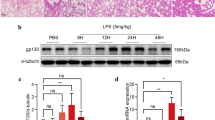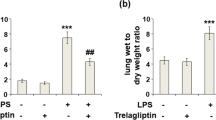Abstract
The objective of the study is to investigate the role and specific molecular mechanism of interleukin-33 (IL-33) acted on acute lung injury (ALI) induced by lipopolysaccharide (LPS). C57BL/6 mice intratracheally instilled LPS to induce ALI model. The mice were randomly divided into three groups: the sham operation group (Sham), ALI group (ALI), and pretreatment with IL-33 of ALI group (IL-33). By observing the survival rate, inflammatory cytokines in bronchoalveolar lavage fluid (BALF), myeloperoxidase (MPO) levels in lung tissue, lung histopathological examination, pulmonary capillary leakage, lung wet/dry (W/D) weight ratio, fibrosis levels in lung tissue, and associated pathways changes among the different groups, comparing to explore the role of IL-33 pretreatment on ALI mice and the possible molecular mechanisms. IL-33 pretreatment overall decreased the survival rate of ALI mice. IL-33 aggravated inflammation reaction showing as increasing the release of proinflammatory cytokines TNF-α and IL-6, increasing MPO levels in lung tissue, and aggravating lung pathology injury. In addition, IL-33 pretreatment further destroyed adherens junctions (AJs) by increasing the phosphorylation of VE-cadherin, resulting in the concomitantly pulmonary capillary barrier damage and pulmonary edema. During this process, mitogen-activated protein kinase (MAPK) pathways further activated. However, IL-33 pretreatment had no significant impact on collagen content of lung tissue. Our results indicated that IL-33 aggravated inflammatory reaction and increased microvascular permeability, but had little effect on pulmonary fibrosis, associated with the further activation of MAPK family proteins in the process. To sum up, IL-33 decreased survival rate and aggravated LPS-induced ALI.





Similar content being viewed by others
References
Wheeler, A.P., and G.R. Bernard. 2007. Acute lung injury and the acute respiratory distress syndrome: A clinical review. Lancet 369: 1553–1564.
Matthay, M.A., L.B. Ware, and G.A. Zimmerman. 2012. The acute respiratory distress syndrome. The Journal of Clinical Investigation 122: 2731–2740.
Parekh, D., R.C. Dancer, and D.R. Thickett. 2011. Acute lung injury. Clinical Medicine (Lond) 11: 615–618.
Espinassous, Q., E. Garcia-de-Paco, I. Garcia-Verdugo, M. Synguelakis, S. von Aulock, J.M. Sallenave, et al. 2009. IL-33 enhances lipopolysaccharide-induced inflammatory cytokine production from mouse macrophages by regulating lipopolysaccharide receptor complex. Journal of Immunology (Baltimore, Md. : 1950) 183: 1446–1455.
Tian, J., Y. Wang, Z. He, Y. Gao, J.E. Rundhaug, and X. Wang. 2011. Hydroxyethyl starch (130 kD) inhibits Toll-like receptor 4 signaling pathways in rat lungs challenged with lipopolysaccharide. Anesthesia and Analgesia 113: 112–119.
Biswas, S.K., P. Bist, M.K. Dhillon, T. Kajiji, C. Del Fresno, M. Yamamoto, et al. 2007. Role for MyD88-independent, TRIF pathway in lipid A/TLR4-induced endotoxin tolerance. Journal of Immunology (Baltimore, Md. : 1950) 179: 4083–4092.
Brint, E.K., D. Xu, H. Liu, A. Dunne, A.N. McKenzie, L.A. O’Neill, et al. 2004. ST2 is an inhibitor of interleukin 1 receptor and Toll-like receptor 4 signaling and maintains endotoxin tolerance. Nature Immunology 5: 373–379.
Schmitz, J., A. Owyang, E. Oldham, Y. Song, E. Murphy, T.K. McClanahan, et al. 2005. IL-33, an interleukin-1-like cytokine that signals via the IL-1 receptor-related protein ST2 and induces T helper type 2-associated cytokines. Immunity 23: 479–490.
Alves-Filho, J.C., F. Sonego, F.O. Souto, A. Freitas, W.A. Verri Jr., M. Auxiliadora-Martins, et al. 2010. Interleukin-33 attenuates sepsis by enhancing neutrophil influx to the site of infection. Nature Medicine 16: 708–712.
Roger, T., and T. Calandra. 2010. Interleukin-33 safeguards neutrophils in sepsis. Nature Medicine 16: 638–639.
Oboki, K., T. Ohno, N. Kajiwara, K. Arae, H. Morita, A. Ishii, et al. 2010. IL-33 is a crucial amplifier of innate rather than acquired immunity. Proceedings of the National Academy of Sciences of the United States of America 107: 18581–18586.
Lu, J., J. Kang, C. Zhang, and X. Zhang. 2015. The role of IL-33/ST2L signals in the immune cells. Immunology Letters 164: 11–17.
Nabe, T. 2014. Interleukin (IL)-33: New therapeutic target for atopic diseases. Journal of Pharmacological Sciences 126: 85–91.
Yagami, A., K. Orihara, H. Morita, K. Futamura, N. Hashimoto, K. Matsumoto, et al. 2010. IL-33 mediates inflammatory responses in human lung tissue cells. Journal of Immunology (Baltimore, Md. : 1950) 185: 5743–5750.
Dushianthan, A., M.P. Grocott, A.D. Postle, and R. Cusack. 2011. Acute respiratory distress syndrome and acute lung injury. Postgraduate Medical Journal 87: 612–622.
Piper, A., Y. Song, N.D. Eves, and T.M. Maher. 2014. Year in review 2013: Acute lung injury, interstitial lung diseases, sleep and physiology. Respirology (Carlton, Vic) 19: 428–437.
Liew, F.Y., N.I. Pitman, and I.B. McInnes. 2010. Disease-associated functions of IL-33: The new kid in the IL-1 family. Nature Reviews Immunology 10: 103–110.
Lingel, A., T.M. Weiss, M. Niebuhr, B. Pan, B.A. Appleton, C. Wiesmann, et al. 2009. Structure of IL-33 and its interaction with the ST2 and IL-1RAcP receptors—Insight into heterotrimeric IL-1 signaling complexes. Structure 17: 1398–1410.
Chichger, H., H. Duong, J. Braza, and E.O. Harrington. 2015. p18, a novel adaptor protein, regulates pulmonary endothelial barrier function via enhanced endocytic recycling of VE-cadherin. FASEB Journal 29: 868–881.
Fainaru, O., I. Adini, O. Benny, L. Bazinet, E. Pravda, R. D’Amato, et al. 2008. Doxycycline induces membrane expression of VE-cadherin on endothelial cells and prevents vascular hyperpermeability. FASEB Journal 22: 3728–3735.
Gong, H., J. Rehman, H. Tang, K. Wary, M. Mittal, P. Chaturvedi, et al. 2015. HIF2alpha signaling inhibits adherens junctional disruption in acute lung injury. The Journal of Clinical Investigation 125: 652–664.
Semina, E.V., K.A. Rubina, V.Y. Sysoeva, P.N. Rutkevich, N.M. Kashirina, and V.A. Tkachuk. 2014. Novel mechanism regulating endothelial permeability via T-cadherin-dependent VE-cadherin phosphorylation and clathrin-mediated endocytosis. Molecular and Cellular Biochemistry 387: 39–53.
Li, Y.C., C.H. Yeh, M.L. Yang, and Y.H. Kuan. 2012. Luteolin suppresses inflammatory mediator expression by blocking the Akt/NFkappaB pathway in acute lung injury induced by lipopolysaccharide in mice. Evidence-based Complementary and Alternative Medicine 2012: 383608.
Reutershan, J., M.A. Morris, T.L. Burcin, D.F. Smith, D. Chang, M.S. Saprito, et al. 2006. Critical role of endothelial CXCR2 in LPS-induced neutrophil migration into the lung. The Journal of Clinical Investigation 116: 695–702.
Liu, G., Y.J. Park, Y. Tsuruta, E. Lorne, and E. Abraham. 2009. p53 Attenuates lipopolysaccharide-induced NF-kappaB activation and acute lung injury. Journal of Immunology (Baltimore, Md. : 1950) 182: 5063–5071.
Antonov, A., C. Snead, B. Gorshkov, G.N. Antonova, A.D. Verin, and J.D. Catravas. 2008. Heat shock protein 90 inhibitors protect and restore pulmonary endothelial barrier function. American Journal of Respiratory Cell and Molecular Biology 39: 551–559.
Okutani, D. 2006. Src protein tyrosine kinase family and acute lung injury. Nihon Rinsho Men’eki Gakkai kaishi = Japanese journal of clinical immunology 29: 334–341.
Gong, P., D.J. Angelini, S. Yang, G. Xia, A.S. Cross, D. Mann, et al. 2008. TLR4 signaling is coupled to SRC family kinase activation, tyrosine phosphorylation of zonula adherens proteins, and opening of the paracellular pathway in human lung microvascular endothelia. The Journal of Biological Chemistry 283: 13437–13449.
Iikura, M., H. Suto, N. Kajiwara, K. Oboki, T. Ohno, Y. Okayama, et al. 2007. IL-33 can promote survival, adhesion and cytokine production in human mast cells. Laboratory Investigation 87: 971–978.
Sui, X., N. Kong, L. Ye, W. Han, J. Zhou, Q. Zhang, et al. 2014. p38 and JNK MAPK pathways control the balance of apoptosis and autophagy in response to chemotherapeutic agents. Cancer Letters 344: 174–179.
Komai-Koma, M., D. Xu, Y. Li, A.N. McKenzie, I.B. McInnes, and F.Y. Liew. 2007. IL-33 is a chemoattractant for human Th2 cells. European Journal of Immunology 37: 2779–2786.
Xu, D., W.L. Chan, B.P. Leung, F. Huang, R. Wheeler, D. Piedrafita, et al. 1998. Selective expression of a stable cell surface molecule on type 2 but not type 1 helper T cells. The Journal of Experimental Medicine 187: 787–794.
Smith, D.E. 2011. The biological paths of IL-1 family members IL-18 and IL-33. Journal of Leukocyte Biology 89: 383–392.
Acknowledgements
This study was supported by grants from the National Natural Science Foundation of China (81171639) and Provincial Natural Science Foundation of Zhejiang (LQ16H150001).
Authors’ Contributions
Junran Xie and Ran Lv conceived and designed the experiments and supervised the project. Yaping Zhang performed experiments and interpreted the data. All the authors participated in manuscript writing and approved the final manuscript.
Author information
Authors and Affiliations
Corresponding author
Ethics declarations
Conflict of Interest
The authors declare they have no conflict of interest.




